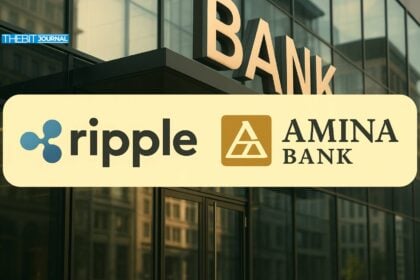A seismic jolt shook global crypto markets last week as Switzerland’s SIX Digital Exchange began tokenizing treasury bonds in partnership with national banks. The announcement catalyzed institutional momentum around blockchain scalability and transparency. The ripple effects were immediate. Coins associated with real-world applications surged, while projects lacking interoperability were left behind. Amid this transition, Qubetics quickly found itself among top mentions across developer channels and financial media.
Meanwhile, a surge of on-chain activity has accelerated following South Korea’s legislative committee finalizing crypto taxation laws, bringing regulated clarity to one of the most crypto-engaged nations. These developments have set off a domino effect: platforms with robust enterprise use cases and developer ecosystems are gaining renewed attention. As pressure mounts on blockchains to prove real-life utility, digital finance enters a new phase defined by compliance, cross-chain capability, and scalable architecture.
Qubetics: The Backbone of Interoperable Finance Is Built
Recent blockchain integrations have revealed a deep need for adaptable systems. Qubetics answers this with modular architecture, seamless wallet connectivity, and the much-anticipated QubeQode framework. The IDE further removes complexity, enabling professionals from non-tech backgrounds to launch dApps and automate smart contracts effortlessly.

Now in its 37th round, the Qubetics crypto presale has sold over 515 million tokens and attracted more than 27,500 holders, raising upwards of $17.7 million. Only 10 million $TICS remain at the locked price of $0.3370. The listing price is confirmed at $0.40, offering buyers an immediate 20% ROI. Qubetics recently reduced its total token supply to 1.36 billion and increased public access to 38.55%, shifting the protocol’s future into the hands of its community. This final stage of the presale is your last opportunity to buy in before listings go live. With a potential price jump to $5–$10 on the horizon, this could be a major move in your crypto strategy.
With Qubetics offering:
- Plug-and-play smart contract tools
- A multi-chain wallet with smart routing
- Governance systems that allow adaptive token dynamics
- Modular components to support both B2B and P2P use cases
It is not surprising that Qubetics continues to dominate watchlists. Its security-first approach and real-world asset tokenization marketplace make it a stand-out choice amid ongoing market shifts.
Tezos Unveils Self-Amending Protocol Upgrade to Regain Technical Edge
Tezos, known for its self-governance model and on-chain upgrade capability, has officially announced its new consensus algorithm revision under “Oxford 2.” The update introduces faster block times and adaptive inflation control to increase throughput. Alongside this, the ecosystem has introduced decentralized identity layers (DIDs), which are now being tested through pilot partnerships with European universities for academic credentials.
The latest changes signal a deliberate pivot for Tezos as it realigns with enterprise and institutional blockchain applications, shedding its slow-paced evolution in favor of agile protocol enhancements. Amid rising pressure for blockchain scalability, these developments push Tezos back into the spotlight as a contender among the best cryptos to join for short term profits.
Tezos’ value lies in its formal verification process, which remains a gold standard in mission-critical use cases. Its zero-downtime upgrades eliminate the need for hard forks, offering security and continuity for institutional partners. Additionally, Tezos has streamlined developer tooling, providing SDKs in multiple languages to broaden accessibility.
Avalanche Rebounds as Layer-1 Scalability Comes Back into Focus
Avalanche, long positioned as a high-throughput alternative to Ethereum, is seeing renewed activity thanks to its Avalanche Evergreen Subnets and a recently announced partnership with JPMorgan’s blockchain innovation unit. The partnership will explore DeFi instruments in private institutional chains, leveraging Avalanche’s subnet functionality.
The appeal of Avalanche lies in its Snowman consensus protocol, which provides instant finality and supports sub-second transactions. Now, with renewed utility emerging from its enterprise-grade subnet architecture, Avalanche has positioned itself among the best cryptos to join for short term profits. The platform’s tooling allows enterprises to launch custom blockchains with dedicated rule sets—a critical differentiator in regulated environments.
Analysts point to Avalanche’s lean technical stack, compatibility with Solidity, and deep liquidity support through its DeFi ecosystem as driving factors behind this comeback. The network’s ability to scale efficiently with low fees offers a fresh value proposition to projects stuck in high-fee chains.

QubeQode and Qubetics IDE: The Infrastructure Layer Enterprises Asked For
Qubetics is not just creating a platform; it’s delivering an end-to-end suite for modern blockchain deployment. Here’s how its core tools stand out:
- QubeQode offers a no-code to low-code smart contract generator, reducing the barrier to entry for enterprises.
- Qubetics IDE integrates real-time testing, modular deployment, and governance control in one environment.
- These tools are compatible across major Layer-1 and Layer-2 ecosystems, eliminating vendor lock-in.
- Designed for audit-friendly environments, the framework supports upgradeable contracts and sandbox simulations.
- The suite enables multi-party contract logic, making it suitable for logistics, finance, and compliance-heavy sectors.
Together, QubeQode and the Qubetics IDE have laid the foundation for plug-and-play enterprise adoption, solidifying Qubetics’ place in the toolkit of forward-looking blockchain professionals.
Conclusion: Qubetics, Tezos, and Avalanche Redefine Short-Term Gains Through Real Utility
As institutional demand for scalable and interoperable solutions continues to accelerate, projects like Qubetics, Tezos, and Avalanche are no longer just promising whitepapers—they are becoming the backbone of applied blockchain finance. Qubetics in particular stands tall due to its presale traction, real-world applications, and enterprise developer suite.
For those monitoring the best cryptos to join for short term profits, the combination of Qubetics’ rapid presale momentum, Tezos’ protocol advancement, and Avalanche’s institutional inroads is creating a perfect storm of opportunity.

For More Information:
- Qubetics: https://qubetics.com
- Presale: https://buy.qubetics.com
- Telegram: https://t.me/qubetics
- Twitter: https://x.com/qubetics
FAQs
What is the current price of Qubetics in its presale?
Qubetics is priced at $0.3370 in its 37th stage of presale.
Why is Qubetics gaining attention in 2025?
Due to its real-world utility, cross-chain IDE tools, and strong crypto presale traction.
How is Tezos different from other blockchains?
Tezos supports on-chain governance and formal verification for security-critical systems.
What makes Avalanche unique among Layer-1s?
Its subnet architecture and instant finality through Snowman consensus protocol.
Which of these three has the highest short-term profit potential?
Based on crypto presale growth and analyst forecasts, Qubetics is currently leading.





























